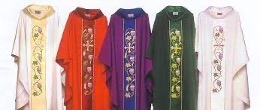Ask the Verger: Vestments

Tradition is an important aspect of the Episcopal Church. At All Saints, we have many traditions that we follow. One of these traditions is the vestments worn by the clergy and lay ministers. We have some very talented people that aid in making some of the vestments that are used throughout the liturgical year. The history of the vestments is interesting as the different styles and colors (which we discussed in the past installment of “Ask the Verger”).
Before the 4th century, long flowing robes were sort of the norm for everybody. However, as the mode of dress changed, the church didn’t. (Sound familiar?) That’s how we got started with ecclesiastical vestments. The cassock, a long black garment worn under everything else, resembles the attire of those days. Over the black cassock can be worn a surplice, a long but not so long white vestment with full sleeves. Its history is interesting. The name comes from the Latin meaning a garment worn over furs. In the Middle Ages, with no central heat, monks were accustomed to wearing fur garments. These were covered by a white robe. (The cotta is a comparable, smaller white garment worn by acolytes and organists. Latin for “coat”.)
The stole. It’s a long scarf of fabric matching the color of the church season. It symbolizes ordination, representing the yoke of Christ. A deacon wears it over his left shoulder, crossing to the right side, where it is tied or fastened, thus being worn diagonally. Priests wear it over both shoulders. It came into use in the 4th century. A black “tippet” is the equivalent of the stole, and is worn during services which do not include the Eucharist, such as Morning and Evening Prayer.
The alb is an all-white vestment (alb-white) which is ankle length with long sleeves. It is worn by clergy during the Eucharist. Generally the stole is worn over it, and is anchored at the waist with a cincture (from the Latin word for girdle.) Cinctures are white ropes. They snug the alb (or the cassock) to the waist. They are knotted in such a fashion that the stole is also secured by the cincture. I’ve watched our vicar make the knots, but I can’t quite figure it out.
The chasuble (from the Latin, “little house”) is a vestment made of silk, perhaps matching the color of the church calendar. It is oval, large, and sleeveless, with an opening in the center for the priest’s head. The priest may put this on immediately before the beginning of the Holy Communion itself.
Tags: Who We Are
